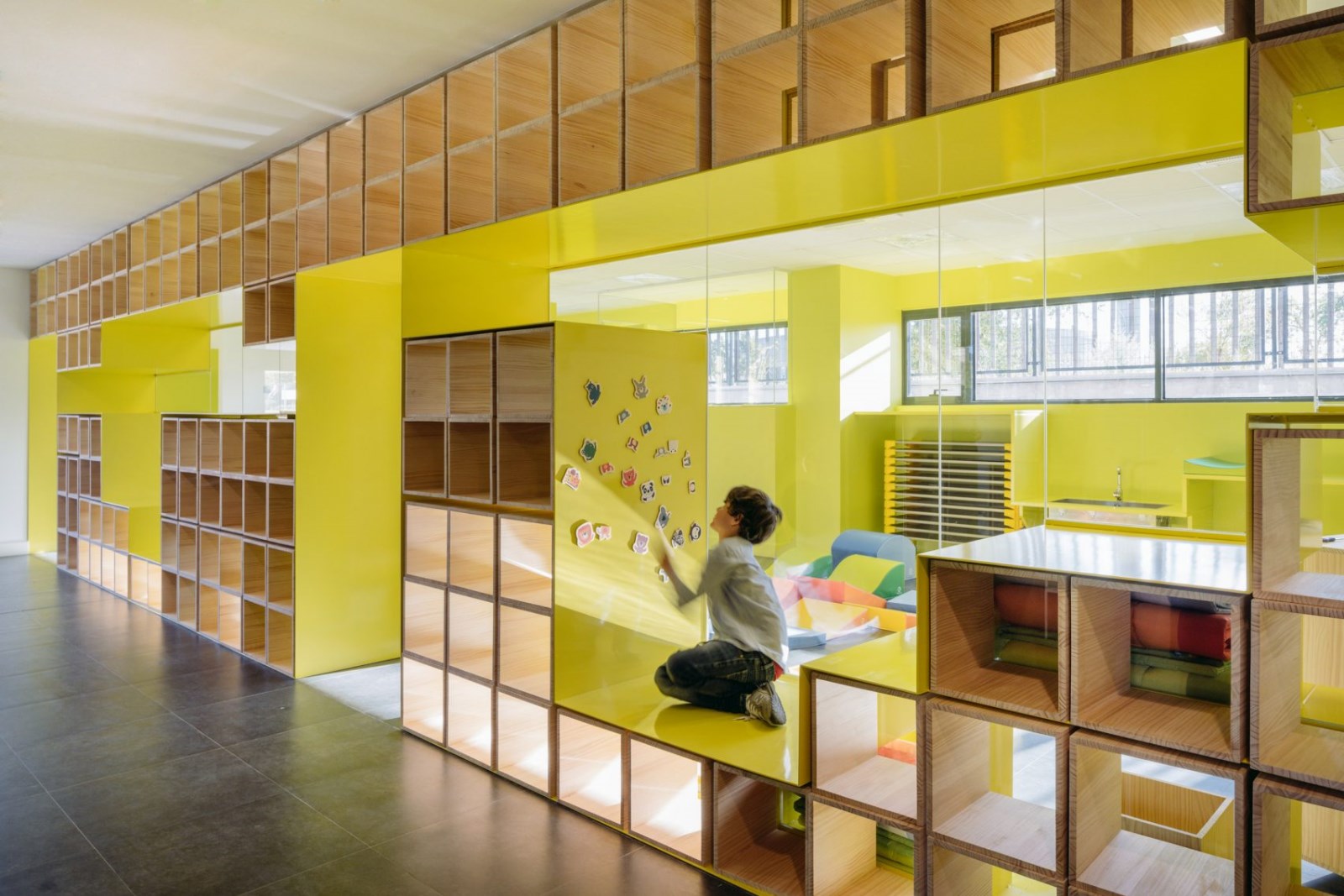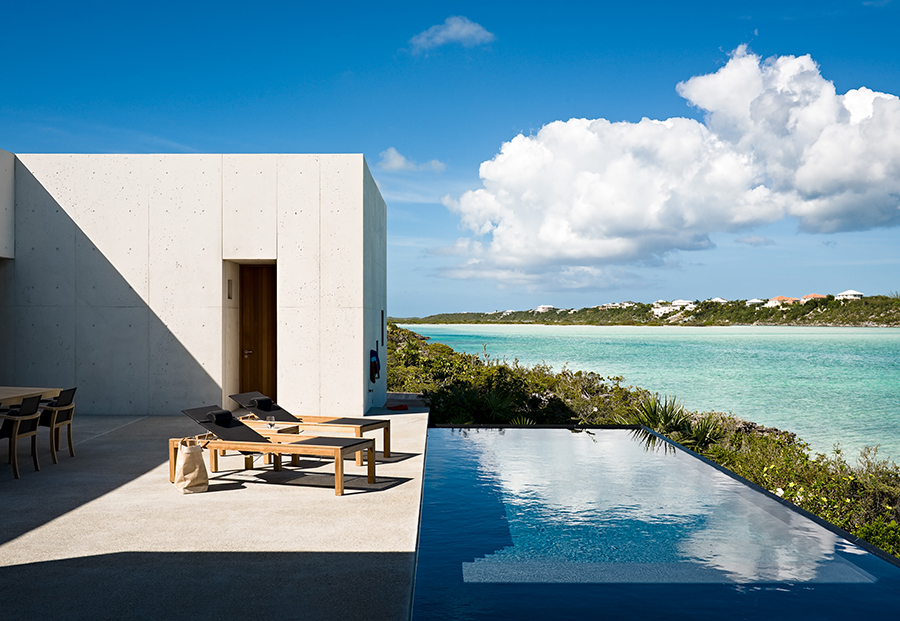Tapis Rouge public space in an informal neighborhood in Haiti Emergent Vernacular Architecture (EVA Studio)
2017-01-12 15:00
© Etienne Pernot du Breuil
(Etienne Pernot Du Breuil)
架构师提供的文本描述。Tapis Rouge是海地家乐福的几个公共空间之一,它是根据LAMIKA计划建造的,它的首字母缩写是海地克里奥尔语中的“我的邻里生活更美好”。该方案由美国红十字会资助,由全球社区实施,目的是通过包容性的方式,建设多功能空间,促进和促进社会凝聚力。
Text description provided by the architects. Tapis Rouge is one of several public spaces in Carrefour-Feuilles, Haiti, built under program LAMIKA, whose acronym stands for “A better life in my neighbourhood” in Haitian Creole. The program, funded by the American Red Cross and implemented by Global Communities, aims to construct multifunctional spaces that facilitate and promote social cohesion through an inclusive approach.
家乐福是许多在2010年地震中遭受广泛破坏的非正式社区之一。依附在峡谷斜坡上的房屋缺乏基本服务,如电力、自来水和卫生设施。这里几乎没有正式的基础设施,只有沿着斜坡蜿蜒而行的狭窄走廊才能接近那些挨家挨户的住宅。社会生活通常是在紧邻的角落和相邻房屋的墙壁之间进行的。
Carrefour-Feuilles is one of the many informal neighbourhoods which suffered extensive damage in the 2010 earthquake. The houses clinging to the slopes of the ravine lack basic services such as electricity, running water and sanitation. There is little formal infrastructure and the cheek by jowl homes are only accessible by a network of narrow corridors that wind up the slope. It is among the tight corners and between the walls of neighbouring houses that social life usually takes place.
© Etienne Pernot du Breuil
(Etienne Pernot Du Breuil)
地震发生后,塔皮斯·鲁日的营地曾是流离失所者的帐篷营地。它坐落在一个俯瞰峡谷两边的斜坡的顶端,它标志着通往下面的小巷和房屋的入口。
After the earthquake, the site of Tapis Rouge used to be a tent camp for displaced people. It sits at the top of a slope overlooking the ravines either side and it marks the entrance to the alleyways and homes below.
设计本身本质上是以社区为导向的,并将公共空间理解为身份和社会关系成长的人类学背景。通过一种参与性方法,并通过将社区参与置于设计过程的核心,这一公共空间旨在为当地社区赋予变革性权力,并为居民提供一种所有权、认同感和自豪感。其目标是创造一个更安全、更清洁的环境,这将有助于减少该地区的犯罪、暴力和反社会行为。
The design itself is inherently community-oriented and understands public space as an anthropological ground from which identity and social relations grow. Through a participatory approach and through placing community engagement at the core of the design process, this public space aims to give transformative power to a local community and to provide the residents with a sense of ownership, identity, and pride. The goal was to create a safer and cleaner environment, which would help reduce crime, violence, and anti-social behaviour in the area.
该方案和建筑设计已与社区直接建立。一个露天竞技场,旨在社区聚会,标志着中心的空间.座位台阶的边缘点缀着几个华而不实的人,当他们长大成人后,就能遮挡住使用者的阳光。广场内的同心圆圈超过了界定范围。一个是户外运动设备和座位。在另一个靠近墙的地方,当地制作的蓝色摊铺机让位于绿色植物的梯田,每一种都有不同的植物。在它的顶部,一排棕榈树隐藏着邻近的输水站的储水箱。为储罐和车站供水的井从地下100米处取水。出售水所产生的收入将再投资于维持公共空间。
The program and the architectural design have been established directly with the community. An open-air amphitheatre, intended for community gathering, marks the centre of the space. Dotted around the edges of the seating-steps are several Flamboyant’s that, when fully grown, will shelter the users from the sun. The concentric rings beyond define areas within the plaza. One, is occupied by outdoor exercise equipment and seating. In another one, near the wall, the locally-made blue pavers give way to terraces of greenery, each with different plants. Above it, by the top end, a row of palm trees conceals storage tanks for the adjacent water distribution station. The well that feeds the tanks and station brings water from 100m below ground. The revenue generated from the sales of water will be reinvested into maintaining the public space.
沿着遗址周边的墙已经被社区和当地的艺术家改造了,他们的壁画五颜六色。这些设计产生于一个社区参与讲习班,艺术家们在讲习班中与邻里的人讨论艺术的价值。来自这个地区的孩子们、他们的父母和来自法国艺术中心的艺术家鲍特一起完成了最后一件作品,这反映了海地丰富的绘画传统。
The wall that runs along the perimeter of the site has been transformed by the community and local artists with colourful murals. The designs emerged from one of the community engagement workshops, in which artists discussed the value of art with people from the neighbourhood. The children from the area, their parents and artists from Le Centre d’art and French artist Bault worked together on the final piece, which reflects Haiti’s rich painting tradition.
1. ARCOD – Pre-cast concrete pavers
在广场上创造出生机勃勃的图案的预制混凝土桥面是在海地当地制造的。他们在该项目中的使用已直接与家乐福-富里斯社区进行了讨论。这些生机勃勃的颜色经过了ARCOD测试,目的是为社区提供不同的调色板,这往往是由于缺乏资源而留下的水泥。
The pre-cast concrete pavers that create the vibrant pattern on the plaza have been locally fabricated in Haiti. Their use in the project has been discussed directly with the community of Carrefour-Feuilles. The vibrant colours have been tested with ARCOD and are aimed to provide the community with a different colour palette, which is often left cement-like due to a lack of resources for finishes.
2. Green Energy Solutions – Solar Lights
家乐福-富城的特点是极度贫困,车辆和行人交通不便,电力供应有限。安装太阳能灯的目的是为社区提供更安全和更清洁的环境。
Carrefour-Feuilles is characterized by extreme poverty, poor vehicle and pedestrian circulation and limited access to electricity. The installation of solar lights is aimed to provide the community with a safer and cleaner environment.
© Etienne Pernot du Breuil
(Etienne Pernot Du Breuil)
3. Green Gym – Outdoor workout equipment
作为多功能项目的一部分,社区特别要求的低影响锻炼设备是以直观的方式设计的,用于基于体重的锻炼。绿色健身房也将为公共空间的使用者提供培训。
As part of a multi-functional programme, the low-impact workout equipment, specifically requested by the community, is designed in an intuitive way for weight-based exercises. Green Gym will also provide training to the users of the public space.
Architects Emergent Vernacular Architecture (EVA Studio)
Location Carrefour-Feuilles, Haiti
Architects in Charge Andrea Panizzo, Simone Pagani, Jeannie S. Lee, Gianluca Stefani, Anna Calogero, Etienne Pernot du Breuil, Edoardo Paoletti, Samuel Eliodor, Berrousse Exius, Faudia Pierre, Radim Tkadlec, Clément Davy
Photographs Gianluca Stefani, Etienne Pernot du Breuil
 举报
举报
别默默的看了,快登录帮我评论一下吧!:)
注册
登录
更多评论
相关文章
-

描边风设计中,最容易犯的8种问题分析
2018年走过了四分之一,LOGO设计趋势也清晰了LOGO设计
-

描边风设计中,最容易犯的8种问题分析
2018年走过了四分之一,LOGO设计趋势也清晰了LOGO设计
-

描边风设计中,最容易犯的8种问题分析
2018年走过了四分之一,LOGO设计趋势也清晰了LOGO设计















































































